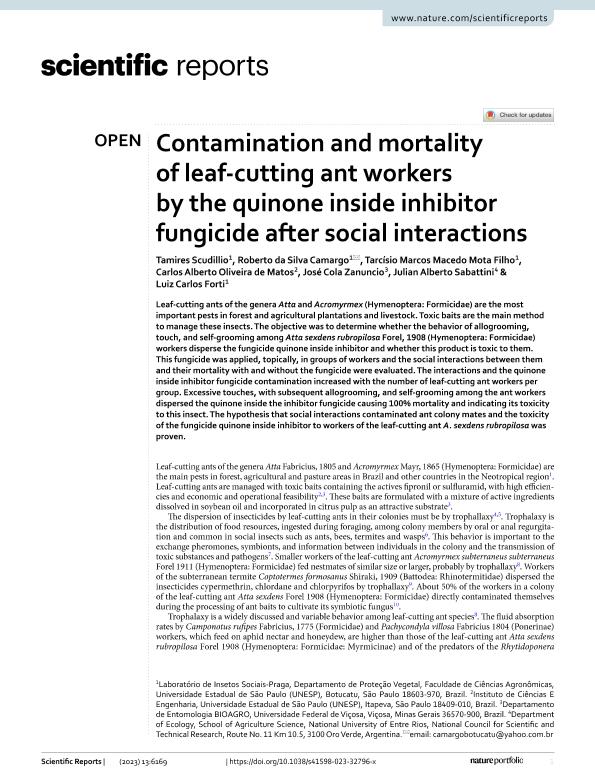Artículo
Contamination and mortality of leaf-cutting ant workers by the quinone inside inhibitor fungicide after social interactions
Scudillio, Tamires; Da Silva Camargo, Roberto; Mota Filho, Tarcísio Marcos Macedo; de Matos, Carlos Alberto Oliveira; Zanuncio, José Cola; Sabattini, Julian Alberto ; Forti, Luiz Carlos
; Forti, Luiz Carlos
 ; Forti, Luiz Carlos
; Forti, Luiz Carlos
Fecha de publicación:
12/2023
Editorial:
Nature Research
Revista:
Scientific Reports
e-ISSN:
2045-2322
Idioma:
Inglés
Tipo de recurso:
Artículo publicado
Clasificación temática:
Resumen
Leaf-cutting ants of the genera Atta and Acromyrmex (Hymenoptera: Formicidae) are the most important pests in forest and agricultural plantations and livestock. Toxic baits are the main method to manage these insects. The objective was to determine whether the behavior of allogrooming, touch, and self-grooming among Atta sexdens rubropilosa Forel, 1908 (Hymenoptera: Formicidae) workers disperse the fungicide quinone inside inhibitor and whether this product is toxic to them. This fungicide was applied, topically, in groups of workers and the social interactions between them and their mortality with and without the fungicide were evaluated. The interactions and the quinone inside inhibitor fungicide contamination increased with the number of leaf-cutting ant workers per group. Excessive touches, with subsequent allogrooming, and self-grooming among the ant workers dispersed the quinone inside the inhibitor fungicide causing 100% mortality and indicating its toxicity to this insect. The hypothesis that social interactions contaminated ant colony mates and the toxicity of the fungicide quinone inside inhibitor to workers of the leaf-cutting ant A. sexdens rubropilosa was proven.
Palabras clave:
Contamination
,
mortality
,
leaf‑cutting
Archivos asociados
Licencia
Identificadores
Colecciones
Articulos(SEDE CENTRAL)
Articulos de SEDE CENTRAL
Articulos de SEDE CENTRAL
Citación
Scudillio, Tamires; Da Silva Camargo, Roberto; Mota Filho, Tarcísio Marcos Macedo; de Matos, Carlos Alberto Oliveira; Zanuncio, José Cola; et al.; Contamination and mortality of leaf-cutting ant workers by the quinone inside inhibitor fungicide after social interactions; Nature Research; Scientific Reports; 13; 1; 12-2023; 1-7
Compartir
Altmétricas



